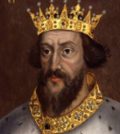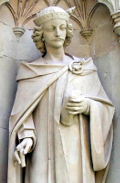King Henry I of England
Henry was the fourth and youngest son of William the Conqueror, who had defeated England's King Harold at the Battle of Hastings in 1066 and assumed the English crown. Henry was born in 1068, in Selby, Yorkshire, while his father was on campaign to subdue a rebellion. 
Henry had his schooling at Abingdon Abbey, studying law and learning English. He also quite liked animals and put together the first zoo in the country at his Oxfordshire palace, Woodstock. Among the animals on display were camels, lions, and tigers. Henry studied hard and came to have a strong knowledge of a wide variety of things, leading to his being called Beauclerc, meaning "Fine Scholar." William the Conqueror died in 1086 and divided his lands among his sons. To his eldest son, Robert, he left the family lands in Normandy. The second son, William, became king of England. The third son, Richard, died young. Henry could lay claims to lands in both Normandy and England and spent much time with his brother Robert in Normandy. Robert wanted to invade England and claim it as well, but he didn't have the support. William did have the support for an invasion of Normandy, and he mounted one, more than once, winning as concessions some lands and titles in Normandy. When Robert left Normandy in 1095 to go on Crusade, William assumed ownership of Normandy. Henry was with his brother on Aug. 2, 1100, on a hunting expedition in the New Forest when William was shot dead. Henry, realizing that he could do nothing for his brother and worried about an insurrection, seized the royal treasury and summoned a kingly council, who proclaimed him king. He was crowned four days later. 
Henry set about turning back the clock, returning the country to some of its practices that were familiar before the Norman Conquest. William had become an unpopular ruler. One of the first things that Henry did as king was to imprison Ranulf Flambard, William's chief justiciar. He also asked Anselm, the Archbishop of Canterbury, who was extremely popular with the Anglo-Saxon English, to return. (William had banished him.) Another way in which Henry cemented his relationship with the populace was a proclamation known as the Charter of Liberties. With his brother's mistreatment of the people in mind, Henry agreed to issue the Charter, which he issued when he took the throne. (It was also called the Coronation Charter.) The Charter had 14 declarations, essentially promises that the king vowed basically to keep himself in line and not abuse his privilege regarding the barons or the clergy in terms of taxation or seizing of property. In particular, one of the declarations gives to widows the right to remarry according to their own wishes. He also set about finding a queen. Henry chose as his wife Edith (later known as Matilda), the oldest daughter of Scotland's King Malcolm Canmore. Edith's mother, Margaret, was the granddaughter of King Edmund Ironside, who had ruled England just before Harold; so any children of Henry and Edith could claim bloodlines of England, Scotland, and Normandy. Robert, meanwhile, had returned from Crusade and decided that he deserved the English crown now that William was dead. Robert found allies in a handful of English barons and marched at the head of a small force to confront Henry. The two sides did not come to blows; instead, the two brothers agreed to return to the territorial arrangement instituted by their father: Henry renounced his claim to Normandy, and Robert agreed not to press his claim for England. Henry punished the barons who had supported Robert, banishing many of them. One of them, Robert of Bellême, fled to Normandy and tried to convince Robert to try again to take the English throne. Henry responded by invading Normandy, at the head of a force of his own. The result was the Battle of Tinchebray, in 1106. The battle ended in a resounding victory for Henry and life imprisonment for Robert. Robert's son, William Clito, took up the mantle a couple of times, but Henry put down both revolts. 
Henry and Edith, renamed Matilda, had two children, William and Matilda. The latter was betrothed to the German Emperor Henry V in 1109 and married five years later. William died in 1120, when the White Ship sank on a return journey from Normandy. Queen Matilda had died two years earlier. Henry took a second wife, Adelicia of Louvain, in 1122. They had no children. In 1126, Henry declared his daughter, whose husband had died, as heir to his throne. All of Henry's barons swore to follow Henry's wishes. In the meantime, Matilda, who had come to be known as Maud, had married again, this time to Geoffrey of Anjou. They had two sons, Henry and Geoffrey, and lived in Normandy. Henry went to Normandy in 1135 to visit his daughter and grandsons. He died there, the victim of ptomaine poisoning, after eating a meal of lamprey, which his doctors had forbidden him to eat. Henry really liked the taste of the eels, but they caused him great discomfort at the best of times. He was returned to England and laid to rest in Reading Abbey. 
Henry's legacy was that of an able administrator. He created the position of royal exchequer and a professional bureaucracy that learned to function without him (given his occasional absences to put down rebellions in Normandy). He also instituted a system of traveling judges. He was known as a man of reason, not irrational action. The English historian William of Malmesbury, a contemporary, said of Henry, "He preferred to contend by council rather than by the sword." |
|
Social Studies for Kids
copyright 2002–2025
David White




